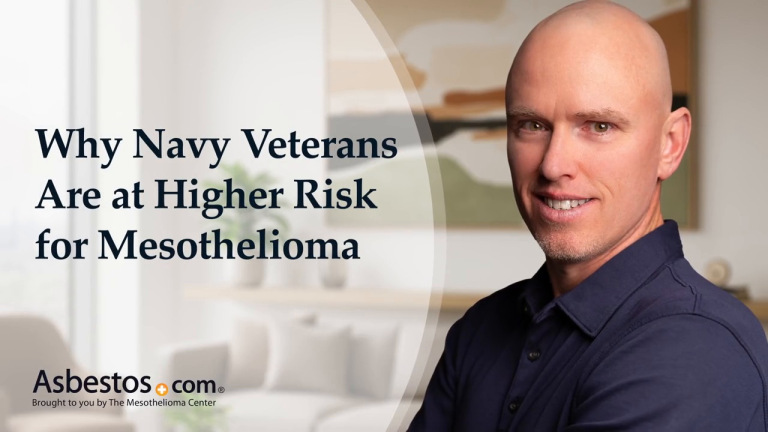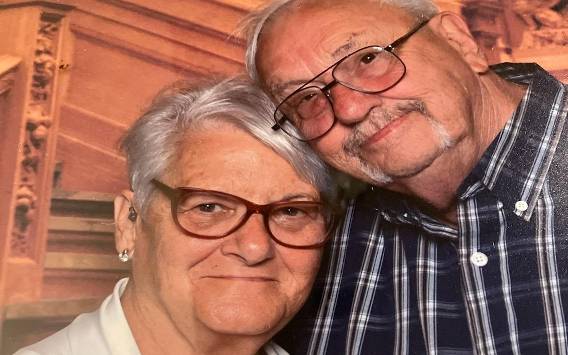Access Free VA Claims Assistance

Free Cancer Guide for Veterans

Find a Top Mesothelioma Doctor

Navy veterans face a higher risk of mesothelioma from asbestos exposure on ships. Asbestos is the leading cause of this cancer. In addition to VA-benefits, veterans may qualify for financial compensation. Legal settlements often range from $1 million to $2 million.

Exclusive Content
Aaron Munz: How Can The Mesothelioma Center Help Veterans

Exclusive Content
Aaron Munz: How Can The Mesothelioma Center Help Veterans
Navy veterans are among those in the military who experienced the highest rates of asbestos exposure, putting them at significant risk of developing diseases like mesothelioma. The primary cause of this aggressive cancer is asbestos exposure. The Department of Defense has identified 18 Military Occupational Specialties in the Navy that are considered “highly probable” for asbestos exposure.
Because of their resistance to heat, the U.S. Navy relied heavily on asbestos products from the 1930s through the early 1980s, especially on ships. A significant percentage of people diagnosed with mesothelioma are military veterans, with the highest rates in the Navy.
Navy veteran John Conway served on naval vessels involved in retrieving Mercury, Gemini and Apollo space capsules. While assigned to the USS Wasp, he also worked stripping asbestos from pipes below deck. “It used to look like it was snowing down there,” he told us. At the time, he and other sailors were unaware of the health risks exposure to asbestos posed.
I grew up wanting to be in the Navy, probably since I was 12 years old. I was proud to be there, proud to serve. It was fun, too. It took me around the world three times. I never thought about any long-range danger.
Navy veterans are still at a higher risk of developing mesothelioma. Irritation from asbestos fibers inhaled decades ago can take 20 to 60 years to develop into mesothelioma. Navy veterans are usually diagnosed long after their time in service.
It’s important to share your asbestos exposure history with your doctor. Regular screenings and VA support are important for early diagnosis.
While veterans with heavy and prolonged exposure during the period of heaviest asbestos use are most at risk, younger veterans and their families can also be exposed. Legacy asbestos products remain in older ships and buildings on bases. Navy personnel can also accidentally carry fibers home on their uniforms, skin or hair, putting family members at risk through secondary exposure.
Access Free VA Claims Assistance

Free Cancer Guide for Veterans

Find a Top Mesothelioma Doctor

Asbestos was heavily used in ships and shipyards in insulation and fireproofing materials. It was found throughout Navy vessels in equipment, pipes and engine rooms. Navy base housing and buildings also contained asbestos products, putting service members, civilian workers and military families at risk.
Asbestos Exposure in the Navy
Even today, personnel in combat zones may be exposed if older buildings are damaged. Veterans of the U.S. Navy, Coast Guard and Merchant Marine all face potential asbestos exposure from various sources during their service.
In addition to the DOD’s list of high risk occupations, the Department of Veterans Affairs lists many military jobs and settings with high asbestos risk. This list of high-risk jobs includes shipyards, construction, demolition, carpentry, roofing and working with brake linings.
Shipyard workers are also at risk when dismantling decommissioned ships built with asbestos-containing materials. Jobs like fire controlman and firefighter posed a significant risk from burning asbestos products. Some gear for fire crews was made with asbestos for its fire resistance.
Highest-Risk Navy Occupations
This list helps the VA decide who may qualify for disability benefits related to asbestos exposure. Mesothelioma is a disease the VA recognizes as connected to military service, particularly in the Navy. The VA acknowledges the link between the Navy’s history of heavy asbestos use and mesothelioma and provides benefits and access to treatment.
U.S. Navy ships built from the 1930s through the early 1980s used large amounts of asbestos. The lower decks like engine, boiler and pump rooms were areas with the highest exposure risk. Both Navy sailors and U.S. Marines who lived and worked on these vessels were at risk, even if they didn’t handle asbestos directly.
Poor ventilation and tight quarters allowed asbestos fibers used in insulation, boilers, gaskets and flooring to spread throughout the ship. Aircraft carriers, destroyers, cruisers, submarines and other vessels all contained asbestos in various materials and components.
Shipyards, such as Bremerton Puget Sound, Charleston, Long Beach and San Diego, were also higher-risk work sites. Workers building, repairing or dismantling ships often encountered high concentrations of airborne asbestos. Even today, Navy shipyards and older vessels may still present asbestos hazards, making awareness and monitoring important for veterans and their families.
Asbestos-containing products were used throughout Navy ships, from the deck to the engine room, because of their durability and resistance to heat, fire and saltwater corrosion. Materials like insulation, machine parts and safety gear often contained asbestos and could release harmful fibers when damaged, putting sailors who performed repairs and maintenance at higher risk of exposure.
Naval Asbestos Products
Navy veteran Jim A., who served on the USS Renville in the 1960s, told us, “You could say I was shocked about my pleural mesothelioma diagnosis. But not that big of a shock because I had always wondered after hearing so much about how dangerous asbestos turned out to be. I’m told, though, it was caught early.”

Bob Niemiec
Mesothelioma Survivor, a Navy Veteran, Defies the Odds
Navy veteran Bob Niemiec is a mesothelioma survivor who even doctors say defied the odds. “Every doctor we’ve seen all said it’s impossible medically for this man to still be alive, so it’s just not his time to go,” said Jeannie, his his wife of 55 years. Bob entered the Navy in 1965 at the age of 20. His first assignment out of boot camp was to scrape paint off of the landing ship U.S.S. Hermitage. It turns out the paint he was scraping contained asbestos.
Bob Niemiec
Even those who never worked directly with asbestos can still develop mesothelioma from secondary exposure. This happens when asbestos fibers are brought home on clothing, shoes, equipment and hair, putting family members at risk.
Sailors, shipyard workers and others in shared spaces like barracks or work areas may also expose those around them. Over time, this indirect contact has led to mesothelioma in people who were never directly involved in higher-risk jobs.
U.S. Navy veterans diagnosed with mesothelioma may be eligible for VA benefits such as disability compensation, health care and other financial assistance to help cover treatment costs. Those with a 100% disability rating may receive more than $3,700 in monthly benefits and full access to VA medical care. The VA supports veterans based on service-connected disabilities, medical conditions and financial need.
Available Benefits for Navy Veterans
VA benefits may include medical care and monthly disability compensation for service-connected medical conditions. Veterans who are married, have dependent children or care for family members with special needs may be eligible for additional compensation. These benefits can also extend to spouses and dependent children after the veteran’s passing. Even if your mesothelioma isn’t officially linked to your military service, you may still qualify to receive mesothelioma treatment through the VA health care system.
Navy veterans can file a VA claim for mesothelioma with the help of a VA-accredited claims agent. VA claims agents have the expertise to help you navigate the complicated process, ensuring claims are filed correctly. They can help you gather the military records and medical documentation to support your VA claim, including a written asbestos exposure summary.
As a former U.S. Army Captain and now the director of the Veterans Department at The Mesothelioma Center, I want everyone to know that if you’re looking for information on how to start a claim for an asbestos-related disease, we can help you file a VA claim line by line.

Don’t miss out on the benefits you deserve. Find out what VA benefits are available for veterans like you.
Get a RecordingMesothelioma settlement amounts for U.S. Navy veterans and their families typically range from $1 million to $2 million. In some cases, total awards, including settlements and trial verdicts, have exceeded $70 million for veterans and their loved ones.
Navy veterans cannot sue the U.S. government directly over military asbestos exposure. But they can file claims against the manufacturers of asbestos-containing products used on Navy ships.
Notable Asbestos Verdicts and Settlements Involving U.S. Navy Veterans
Navy veterans and their families can pursue legal settlements to help cover treatment costs, supplement income and pay expenses that VA benefits may not cover. Consulting an experienced mesothelioma lawyer can help you understand your options and guide you through filing a lawsuit or claims with asbestos trust funds, even if you don’t qualify for VA benefits.
The VA health care system provides advanced treatment and expert cancer care for Navy veterans diagnosed with mesothelioma. Treatment options include immunotherapy, chemotherapy, radiation therapy and surgery. The VA also offers accurate diagnosis and access to second opinions from mesothelioma specialists within the VA network.
Mesothelioma Treatment Options for U.S. Navy Veterans
Your treatment plan will depend on many factors, including cancer stage, cell type, overall health and genetic factors. For veterans who don’t live near a specialist, the VA offers virtual appointments and remote case management, allowing experts to guide your treatment online. Additionally, the VA reimburses travel expenses for veterans who need to travel for covered medical care.
There are VA mesothelioma treatment centers across the country. VA medical centers in Boston, Los Angeles, Houston, Miami and Atlanta have mesothelioma specialists.
These VA mesothelioma treatment centers bring together leading specialists and advanced therapies to ensure veterans receive the highest quality care possible. No matter where you’re located, the VA health care system can help connect you to specialized mesothelioma care at a center that meets your needs.

1400 VFW Pkwy West Roxbury, MA 02132
Year Built: Established in 1996
Number of Beds: 539 beds

11301 Wilshire Blvd Los Angeles CA 90073
Year Built: 1977
Number of Beds: 716 beds
The VA has mesothelioma specialists across the country who provide cutting-edge treatments to veterans, including many Navy veterans, coping with this aggressive cancer. These experts specialize in mesothelioma care and have extensive experience managing complex treatment plans aimed at helping patients live longer, healthier lives.
Navy veterans bear a hefty burden of asbestos-related cancers linked to their service. To address this, the VA health care system has partnered with some of the nation’s leading mesothelioma doctors to deliver exceptional cancer care tailored to veterans’ unique needs.

Los Angeles, California
Pleural Specialist | Thoracic Surgery
Expertise: Pleurectomy and Decortication, Clinical Trials
Languages: English, Spanish, Vietnamese

Franklin, Tennessee
Pleural Specialist | Thoracic Surgery
Expertise: Chest Wall Resection Immunotherapy
Languages: English
The Navy discontinued the use of asbestos for new ships and bases in the 1980s. Veterans who served on naval vessels between 1930 and 1980 have a high risk of developing mesothelioma.
Asbestos was not completely removed or encapsulated on existing vessels and facilities until the late 1990s. Veterans who were deployed overseas may also have been exposed to other sources of asbestos.
Navy ships are no longer built with asbestos-containing materials. Ships constructed before the 1980s have had any exposed asbestos removed or encapsulated. Asbestos on Navy ships does not present a health risk unless damaged or disturbed, but it can still be found on some older vessels.
If you believe you were exposed to asbestos while serving in the military, speak with your primary care physician about mesothelioma screenings. In many cases, veterans are eligible for VA asbestos disability benefits to cover the cost of medical bills and other expenses.
You can learn more about VA claims from our FAQ about VA benefits.
Navy veterans with mesothelioma are eligible for monthly VA benefits and health care. Available benefits for Navy veterans also include survivor benefits and specialized health care. Navy veterans may also file a mesothelioma lawsuit or an asbestos trust fund claim. Most legal claims end with a settlement. The average mesothelioma settlement payout is $1 million to $2 million, according to the latest Mealey’s Litigation Report.
In the 1970s, the Navy established the Asbestos Medical Surveillance Program. The AMSP monitors the health of veterans and civilians who were exposed to asbestos while working for the Navy and other military branches. This program helps track the medical status of people with known military occupational asbestos exposure to screen for mesothelioma and asbestosis. It also documents service-related exposure. This is important for filing a VA claim.
Stay up-to-date on treatment, research, clinical trials, doctors and survivors
The information on this website is proprietary and protected. It is not a substitute for professional medical advice, diagnosis or treatment. Any unauthorized or illegal use, copying or dissemination will be prosecuted. Please read our privacy policy and terms of service for more information about our website.
This website and its content may be deemed attorney advertising. Prior results do not predict a similar outcome.
The Mesothelioma Center’s claim as the most trusted resource is based on our more than 150 5-star Google and BBB reviews. Our organization also helps more than half of all mesothelioma patients annually diagnosed.
Your web browser is no longer supported by Microsoft. Update your browser for more security, speed and compatibility.
If you are looking for mesothelioma support, please contact our Patient Advocates at (855) 404-4592
The Mesothelioma Center at Asbestos.com has provided patients and their loved ones the most updated and reliable information on mesothelioma and asbestos exposure since 2006.
Our team of Patient Advocates includes a medical doctor, a registered nurse, health services administrators, veterans, VA-accredited Claims Agents, an oncology patient navigator and hospice care expert. Their combined expertise means we help any mesothelioma patient or loved one through every step of their cancer journey.
More than 30 contributors, including mesothelioma doctors, survivors, health care professionals and other experts, have peer-reviewed our website and written unique research-driven articles to ensure you get the highest-quality medical and health information.
My family has only the highest compliment for the assistance and support that we received from The Mesothelioma Center. This is a staff of compassionate and knowledgeable individuals who respect what your family is experiencing and who go the extra mile to make an unfortunate diagnosis less stressful. Information and assistance were provided by The Mesothelioma Center at no cost to our family.LashawnMesothelioma patient’s daughter


Munz, A. (2025, September 17). Navy Veterans With Mesothelioma. Asbestos.com. Retrieved December 18, 2025, from https://www.asbestos.com/navy/
Munz, Aaron. "Navy Veterans With Mesothelioma." Asbestos.com, 17 Sep 2025, https://www.asbestos.com/navy/.
Munz, Aaron. "Navy Veterans With Mesothelioma." Asbestos.com. Last modified September 17, 2025. https://www.asbestos.com/navy/.
A United States military veteran with knowledge of asbestos exposure reviewed the content on this page to ensure it meets current standards and accuracy.

Retired Culinary Specialist and Senior Chief Nathan Pinner uses his extensive naval leadership, including service at the White House, to better serve other veterans.
Our fact-checking process begins with a thorough review of all sources to ensure they are high quality. Then we cross-check the facts with original medical or scientific reports published by those sources, or we validate the facts with reputable news organizations, medical and scientific experts and other health experts. Each page includes all sources for full transparency.
Please read our editorial guidelines to learn more about our content creation and review process.
